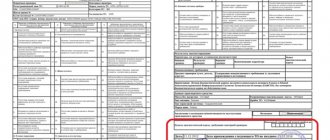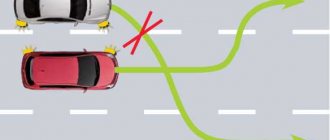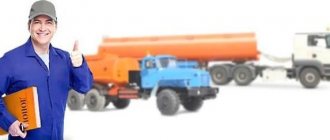What to carry?
The most convenient way to transport any of the devices mentioned is to place it in the back of a pickup truck or minivan. This way you are practically unlimited in speed, while with a trailer on the highway - up to 90 km/h and on a regular road - up to 70 km/h.
Without a trailer, aerodynamics are better and, accordingly, fuel consumption is lower. And the cross-country ability is higher, which is important in the “last mile” before the target. It is more convenient to secure cargo in the back of a pickup truck, since there are usually mounting eyes there. Some trailers, for example, do not have them. But if you can’t do without a trailer, pay attention to the following two points.
We are on Twitter:
Login Registration
Automotive news
Rules for the movement of heavy trucks in the automatic weight control zone have been adopted. The Federal Tax Service has approved the application form for the death or destruction of a vehicle. In Russia, it is forbidden to disembark children without a ticket from buses. A new sign 6.22 has been introduced in the traffic rules - “photo and video recording” Testing for alcohol dependence has been postponed for another year. The Ministry of Health has updated the requirements for completing car first-aid kits, the Ministry of Transport has approved the procedure and terms for storing diagnostic maintenance cards. Obtaining permission for international transport will now be done in a new way. You can now check your MTPL policy for authenticity online. The Central Bank has set new tariffs for MTPL.
/ Legal articles on automobile law / Traffic and safety issues / Rules for transporting goods on a passenger trailer
Rules for transporting goods on a passenger trailer
A trailer is a vehicle, not equipped with an autonomous engine, used for the transportation of goods in conjunction with a motor vehicle. A passenger trailer also belongs to a full-fledged vehicle, and therefore, its improper installation or operation can lead to a threat to the safety of road users.
Parameters of trailers for passenger cars
When driving with a trailer, the car plays the role of a tractor, and the trailer is attached to it using a rigid connecting element - a towbar, which is equipped with electrical wiring and a plug socket. The trailer is equipped with lighting devices: turn signals, brake lights, side lights.
For any type of vehicle, the maximum permissible weight of a loaded trailer is established. If this value is less than 750 kg, then the driver can drive with category “B” (categories “C” and “D” are also allowed). It is allowed to use a trailer with all vehicles of category “B”; its weight should not exceed the weight of the car.
When choosing a trailer, you need to take into account the intended scope of its use. The following types of operation are most typical for passenger cars:
— It is planned to transport building materials, furniture, and use them for other household needs;
— Transportation of snowmobiles, hydro- and ATVs;
Driving with a trailer
When overtaking and braking, it should be taken into account that the presence of a trailer causes a decrease in acceleration dynamics and an increase in braking distance, therefore:
— Braking should be done smoothly, even when there is no load;
— It is necessary to keep a distance from the car in front, and when you need to slow down, you need to do it gradually;
— If you need to turn, you need to start slowing down in advance; turns are driven “pull”. You need to brake without jerking, as this leads to the trailer and the car skidding or “folding”, since when turning, the radius of movement of the trailer wheel is less than the radius of the tractor wheel;
— Maneuvering, changing lanes in traffic and parking are difficult, especially within the city. Particular care is required when driving in reverse, especially with a trailer with a high awning. At increased speed and too much cargo, the trailer begins to swing to the sides;
The amount of fuel consumed when driving with a trailer does not increase noticeably. Typically, the increase in consumption is 5-15% depending on travel conditions and cargo weight (the higher the weight, the higher the consumption).
Paperwork
The trailer must be registered with the traffic police as an independent vehicle, receiving a separate certificate and license plate.
If the owner of the trailer is an individual, its technical inspection is not considered a mandatory procedure; this is only necessary for organizations.
At the request of the traffic police officer, the driver of the car, together with the documents for the car, is obliged to provide registration documents for the trailer.
Travel speed with a trailer and methods of marking the load
In accordance with traffic regulations, the maximum permissible speed for driving with trailers, compared to driving without trailers, is reduced by 20 km. and amounts to:
— 70 km/h on regular roads;
— 90 km/h – on highways;
The distance from the top of a loaded trailer to the road surface should not exceed 4 m, the width of the load cannot be more than 2.55 m. The load at the rear is not allowed to protrude more than 2 m.
If the load protrudes beyond the dimensions of the vehicle by 1 m in front and behind, or by 0.4 m on the side of the side light, it is necessary to install the “Large Load” sign. In addition, at night or in case of poor visibility, red lanterns or reflectors are installed behind, and a white lantern or reflector is installed in front.
If the dimensions are exceeded, the tractor must be equipped with rear-view mirrors on extended brackets.
Download Features
It is prohibited to transport people on cargo trailers or caravan trailers. The weight of the load and its distribution along the axes should not exceed the volumes established during manufacture.
The driver’s responsibilities include placing, securing and securing the cargo so that it does not fall out while driving and does not create interference for road users.
When placing the load, it is necessary to ensure its uniform distribution, and the center of gravity must fall on the axle (if the trailer is single-axle) or axles (if the trailer is two-axle):
If the center of gravity moves forward, the load is placed on the hitch point and the rear of the vehicle, resulting in reduced traction between the front wheels and the road.
If the center of gravity is shifted rearward, it causes the rear of the vehicle to lift and reduce traction between the rear wheels and the road.
The load should not block the driver's view, interfere with control, or disrupt the stability of the vehicle; lighting devices should not obscure hand signals. In addition, the cargo must not pollute the environment.
Be sure to carry chocks (2 pieces) with you to install under the wheels when stopping on sections of the road with a slope.
Before driving, it is the driver’s responsibility to check the technical condition of the vehicle, in particular:
— Checking the presence of lubrication on the tow bar;
— Check for play between the coupling ball and the assembly. If play is detected, it must be eliminated;
— Checking the tire pressure level;
— Checking the reliability of the connection between the safety rope and the chain;
-Checking lighting devices;
It is prohibited to drive if there is a malfunction of the brake or clutch system, a problem with the steering, a malfunction of the headlights and side lights, or a windshield wiper on the driver’s side.
During the journey, the driver is also obliged to ensure that the vehicle is in good working order in full compliance with the rules of safe movement. It is prohibited to make changes to the design of the trailer without the approval of the traffic police.
That's all, good luck on the roads!
Vehicles of category M1
Vehicles not subject to categorization
trailer
18052
No comments yet. Yours will be the first!
Write a comment
New comments
Badyrgy → Removal and expungement of a criminal record under Art. 264.1 of the Criminal Code of the Russian Federation 21 hours ago
Convicted in 2014 of Part 1 of Article 264 of the Criminal Code of the Russian Federation with restriction of freedom and deprivation of rights for 1 year. How to expunge a criminal record? And where to go
Vladimir → Is it necessary to give way to a bus leaving the bus stop… 15 days ago
The rules state that the driver must give way to a bus departing from a stop within the city limits, but I drive at a speed of 60 km per hour at the main speed...
Automotive Lawyer → Deprivation of the right to drive under Art. 264 of the Criminal Code of the Russian Federation. About the most... 1 month ago
Hello. The period of criminal punishment in the form of deprivation of the right to drive runs, regardless of whether the vehicle is passed or not. The traffic police have been punished for enforcing this...
Evgeniy → Deprivation of the right to drive under Art. 264 of the Criminal Code of the Russian Federation. About the most... 1 month ago
Good evening! In 2014, he was convicted under Part 264 of the Criminal Code and served a real sentence of 2 years in a penal colony; the court also deprived him of his license for 3 years, after...
Automotive Lawyer → Deprivation of the right to drive under Art. 264 of the Criminal Code of the Russian Federation. About the most... 1 month ago
Hello. The terms of deprivation under the article of the Code of Administrative Offenses of the Russian Federation and under the article of the Criminal Code of the Russian Federation are not cumulative. Each term is calculated independently, i.e., independently of each other
Category on driver's license
The vast majority of car owners in our country have a category B driver’s license, which allows them to drive vehicles with a gross weight not exceeding 3.5 tons. The Federal Law “On Road Safety” (Article 25) allows a driver with category B to drive category B vehicles with a trailer in two cases:
- the maximum trailer weight does not exceed 750 kg;
- the maximum mass of the trailer exceeds 750 kg, but does not exceed the unladen mass of the vehicle, provided that the total permissible maximum mass of such combination does not exceed 3500 kg.
Transportation of cargo 200 on a light trailer
TRANSPORTATION OF CARGO 200 ON A LIGHT TRAILER
Professional transportation of the deceased/cargo 200 in Russia and abroad by road and air transport. Sale of ritual goods and accessories at manufacturer prices. Own production of ritual goods. Vehicle park. Zinc coffin + certificate of non-investment 9900 rub. The entire list of funeral services: funeral, exhumation, cremation, reburial, organization of funeral services, sending cargo of 200 cars and by air, meeting from abroad, free cemeteries.
Important: When the thought arises of transporting the body of a deceased person in a car trailer, remember that this type of transportation has a significant lack of negative consequences. which you should know about. Remember that our body is made up of 75% water and does not weigh as much as a trailer is designed to carry, meaning a trailer carries approximately 20% of its rated load weight. The shock absorption system of the trailer itself, as everyone knows, is far from perfect and one axle does not make it possible to dampen shaking on very specific road surfaces. Several hours of constant vibration and shaking don't just go away. As a consequence of this, we get the result when the body of the deceased changes and floats, canceling out all the work of the morgue orderlies. After such transportation, the body of the deceased requires repeated cosmetic procedures to restore at least the face of the deceased. in order. Therefore, when deciding to transport the body of the deceased in a car trailer, weigh the pros and cons and make the right decision.
Not so long ago, while organizing the transportation of 200 loads, I, having delivered a bus with ritual accessories that had ordered 200 loads for transportation and handing them over to organize the process of releasing the body to relatives at the morgue, saw nearby, on the territory, a pickup truck with a large passenger trailer. At first I thought that it was one of the staff who simply drove into the territory and left the car, but imagine my amazement when I found out that the customers were planning to transport 200 loads on a light trailer. The passenger trailer was of sufficient length and, moreover, was covered with a plastic casing on top. As an option to save money - it’s worthy, but, of course, you can’t get into people’s heads until the end; what was the point of ordering a decent funeral bus designed to transport 200 loads and for the same money asking a neighbor to transport 200 loads on a passenger trailer? I still don’t understand this, but at the time I was generally in a slight tremor. Of course, it is possible to transport 200 loads on a light trailer, but somehow all this is not correct and not technologically advanced. Even taking into account the fact that a passenger trailer has a rather primitive depreciation system, transporting a load of 200 on a passenger trailer is the same as putting the body of a deceased person in a vibrating machine. The effect of both will be the same. Therefore, to summarize, I do not advise anyone to conduct such experiments as trying to transport a load of 200 on a passenger trailer, especially for the same money.
General rules for towing a trailer hitch
Motorists often travel with trailers at speeds of 140 km/h. Which is not acceptable, but unfortunately happens. Manufacturers recommend sticking to speeds of up to 100 km/h. Decoding the traffic rules looks like this:
- When driving on a motorway without a towed device, the speed limit is 110 km/h. With a trailer, the maximum speed is no higher than 90.
- On other roads outside populated areas without a trailer - 90 km/h, with a trailer - 70 km/h.
- In populated areas, the traffic limit for all vehicles is 60 km/h.
The fine for speeding varies from 500 to 5000 rubles. As well as deprivation of a driver’s license from 4 to 6 months for the first incident and up to 1 year for a second incident, if the violation for speeding is 60-80 km/h. According to traffic regulations, it is prohibited to transport passengers in a trailer, semi-trailer, or caravan trailer. It is prohibited to drive a road train without connecting electrical devices of the trailer to the vehicle, trailer hitch and safety cables. The road sign “driving with a trailer is prohibited” prohibits the movement only of trucks over 3.5 tons, tractors, and self-propelled vehicles.
Things to remember when traveling with a trailer:
- The braking distance of the road train increases.
- The car slowly picks up speed.
- The trailer has inertia.
- The road train is increasing in length.
- The trailer is prone to skidding and can damage the vehicle.
- The BTU can be parked freely and manually.
Basic rules for transportation by passenger cars
The Code of Administrative Offenses does not contain a provision regarding overloading a passenger car. But you shouldn’t overload it, as this affects controllability and maneuverability. Basically, the permissible weight is up to 350 kg, more weight leads to breakdowns - damage to the frame, side member, shock absorbers.
When transporting various objects on the roof, it is necessary to clarify the load limits for this part of the body. The indicator largely depends on the country in which the vehicle was produced:
- for domestic cars - 40–70 kg;
- for imported ones - 60–90 kg.
In this case, heavy things are placed not in the center, but closer to the edge.
The items transported in the trunk are distributed so that the load is uniform over the entire area and the center of gravity is as low as possible. It is important to remember that if the trunk is overloaded, the front part skids when cornering, and when braking sharply, control is lost and the braking distance is lengthened. And few car drivers think about the fact that the poor condition of the roads is often their own fault. An overloaded car sometimes hits the asphalt with its rear bumper, which affects the condition of the pavement.
Any cargo, according to the rules of road transportation, should not block the driver’s view or rear-view mirrors or restrict movement. Law enforcement officers on the roads will not have any claims against the driver if, during such transportation:
- the stability of the machine is not reduced;
- reflectors or headlights are not obscured;
- there is no unnecessary noise or dust;
- the road surface is not damaged.
If at least one of the points is not met, the driver is obliged to immediately eliminate the shortcomings.
After loading, items are securely fixed to prevent accidental fall. All fastenings must be well fixed; they are checked every two hours on the road, and if the surface is damaged or the terrain is difficult or uneven, then this is done hourly.
Furniture doors are taped to prevent them from opening. Glass is transported separately, in special packaging that protects the material from damage and breaking.
The recommended speed of a loaded car trunk should not exceed 100 km/h, if such a mode is allowed on the road along which the route runs. When entering a turn, the speed is reduced to 20 km/h.
Marking
General rules for the transportation of oversized cargo by road are regulated by relevant documents, in particular, the Road Traffic Regulations. In this case, special marking is required, even if cars rather than trucks are used. Signs are attached if the load extends beyond the boundaries of the car by more than 1 meter in front or behind, or 40 cm on the sides.
The “Large Cargo” sign is used for marking. This is a 40x40 cm plate with red and white diagonal stripes. If transportation is carried out in the dark, then a white reflector is additionally installed on the front of the car.
If it happens that there is no sign at hand, and the transportation cannot be postponed or there is nowhere to attach a warning sign, then the cargo is at least marked with a piece of bright fabric, which will not go unnoticed by drivers of other cars. Instead of a reflector, a flashlight is often used.
Tow hooks
The car part is of interest to the traffic police during inspection if it is “handmade” made by the driver or service station specialists. Welding of hooks is regarded as a violation of technical regulations. Such homemade products may be punishable by a fine. In this case, the owner is obliged to restore the vehicle to its original condition, otherwise there is a threat of deregistration. For a self-attached towbar, your license may be revoked if the hook is located very low and overlaps the registration signs.
Trailer
The rules for using a trailer should also not be overlooked. According to the new rules, such motor transport requires a certain category of driver's license.
Category B is intended for driving cars with a trailer, if the permissible maximum weight of the latter does not exceed 750 kg. The trailer may be heavier than the car. At the same time, a limit of 3.5 thousand kg was introduced for the total mass of both vehicles.
Holders of category BE licenses can drive a passenger vehicle with a trailer weighing more than 750 kg, even if this is more than the vehicle weighs without load, and the total weight exceeds 3.5 thousand kg.
How to open the license category for driving a trailer
“BE”, “CE” or “DE”, as well as subcategories “C1E” or “D1E” open after a certain period, and the driver will also have to retake some exams:
- Knowledge of the theory of traffic rules. This exam is ticketed.
- Practical driving around the city;
- Practical driving on the circuit. Includes two exercises: straight driving in reverse and parking in reverse.
It is worth considering: “E” is only issued if you have driving experience “B”, “D” and “C” for at least one year. For example, to open “DE” you need to drive a bus for a period of 12 months with the corresponding category “D”
What the law actually says
The rules for passing exams for obtaining the right to drive a vehicle and obtaining a corresponding certificate from the State Traffic Safety Inspectorate of the Ministry of Internal Affairs of the Russian Federation are established by Decree of the Government of the Russian Federation of October 24, 2014 N 1097 (as amended on March 23, 2017) “On admission to driving vehicles” (together with the “Rules conducting examinations for the right to drive vehicles and issuing driver’s licenses”).
- Drivers of categories “B”, “C” or “D” can drive a road train with a maximum permitted trailer load of up to 0.75 tons;
- If it is higher, but less than the weight of a loaded passenger car, and the total mass of the train is within 3.5 tons, about (clause 8) is enough for control;
- If “E” is present, the motorist can drive a tractor “B”, “D” or “C” with a towed unit (clause 5, clause 4).
That is, obtaining category “E” is necessary when the trailer exceeds the permitted weight of 0.75 tons.
The maximum load is indicated in:
- PTS (item 14);
- Vehicle registration certificate (last line of the front side).
Who is entitled to receive additional information for the operation of a vehicle:
- Category “BE”, “CE” or “DE” - a citizen who has a certificate “B”, “C” and “D” for a period of one year;
- “C1E” or “D1E2” – a person certified in categories “C” or “D”, subcategories “C1” or “D1” for a period of at least one year.









